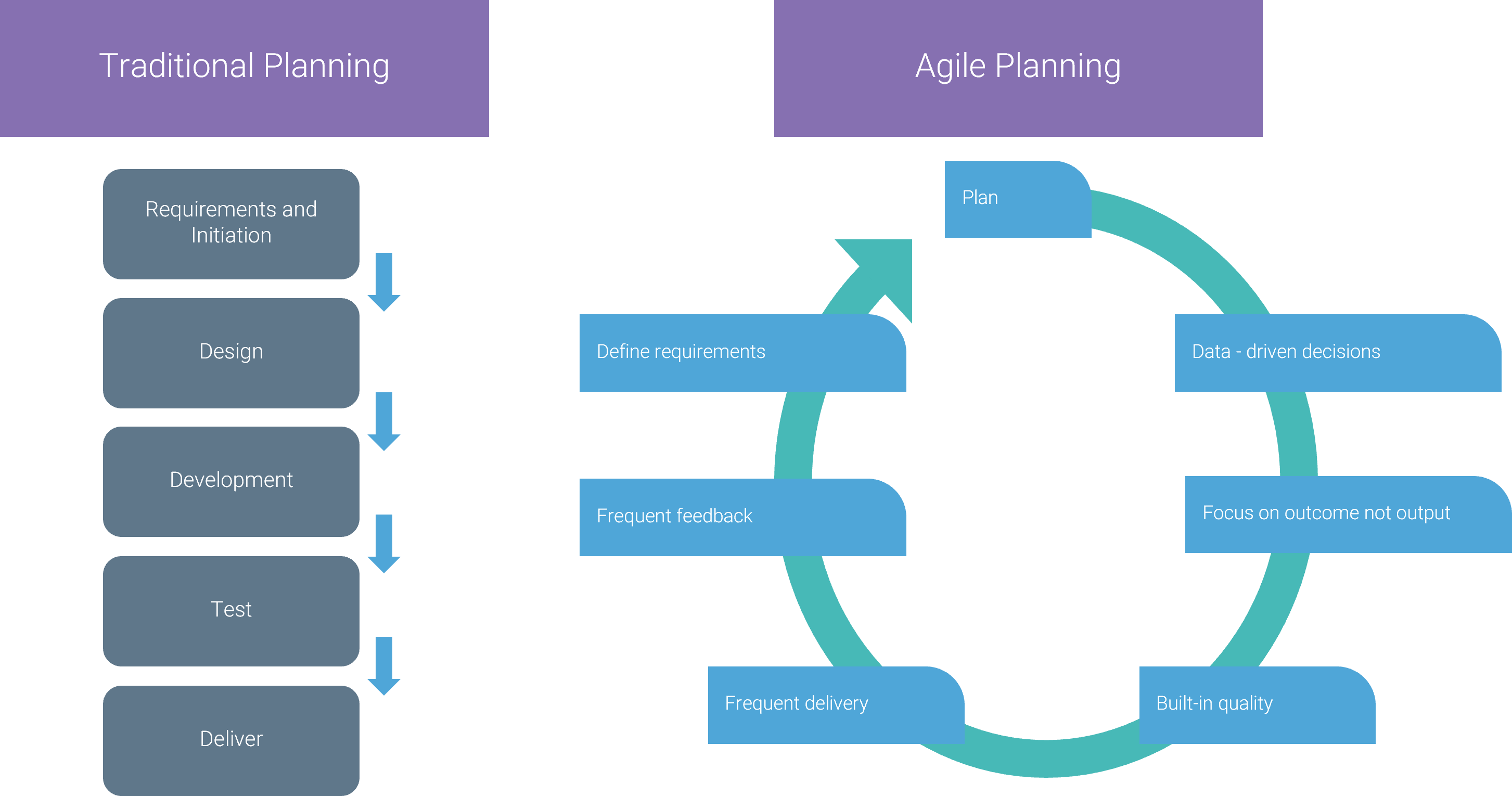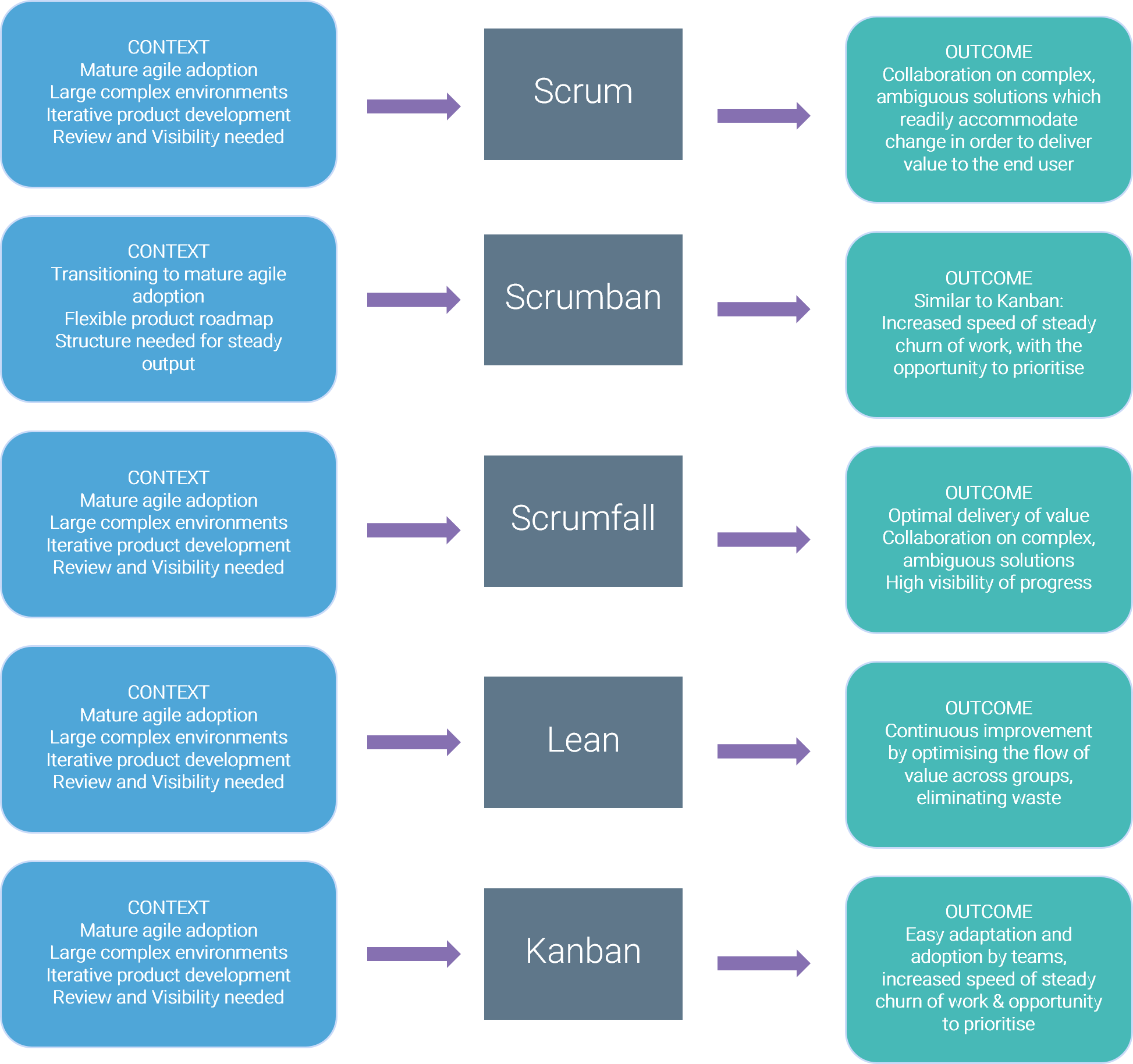Do you work in a complex, traditional organisation and are looking for ways to deliver products or outcomes? If it is important for you to incorporate customer feedback and changes to requirements, whilst retaining control and observability of progress, agile project management might be for you!
Since its conception in the 1990s, ‘agility’ has taken delivery and project management by storm. It has become the norm and desired way of working, promising a quick realisation of value, and adaptability, and facilitating cross-functional teamwork.
Agile project management approaches, in contrast to pure agile methodologies such as Scrum and Kanban, typically maintain the structure and control of project management whilst offering the key benefits of agile. This makes it an attractive proposition for organisations transitioning from more traditional delivery approaches.
This short introductory article covers the basics of agile project management. What it is, its benefits, appropriate application and how you can get started today.
The Basics - What is Agile Project Management
You may have heard it cited frequently on LinkedIn and other spaces, especially in reference to software development - but what does it actually mean? It’s a guarantee that different schools of thought debate vociferously on the topic. The
APM cites the fundamental principle of agile project management as “
an iterative approach to delivering a project throughout its life cycle.” In practice, it may be simplest to understand in relation to traditional linear approaches to projects, such as waterfall or PRINCE2.
Traditional linear approaches tend to be discrete, chronologically ordered project phases starting with initiation, analysis/design, implementation, testing and delivery. Agile project management advocates for incremental and continuous delivery. This can include the following
Starting with limited customer or product requirements
Changes in the market and customer requests mean that product requirements may not be fully elucidated or defined. The principles and processes of agile project management allow for open lines of communication with the customer and market.
Engineering decisions must be based on the principle of flexibility and adaptability in conjunction with delivery. How easy would this be to modify in the future in response to changing requirements, how can we build a flexible foundation on which to build?
Continuous development
Within an engineering context, the principles of continuous development align closely with agility. Engineers should “keep in mind the end-user product” rather than being intrinsically separated from the customer experience. This article wouldn’t do justice to the full detail and scope of continuous development principles such as automation, version control, repeatable processes and shared responsibility, however, it is clear delivery and engineering should be aligned in principle and practice. Delivery should be frequent and provide small increments of value.
Integration of customer feedback
The above two principles rest on the assumption that the relationship with the customer is close and meaningful. Garnering and integrating feedback should be a shared responsibility amongst all project roles- including product owners, engineers and delivery. At the heart of agile project management is delivering value to the customer.
Visually, agile project management vs traditional approaches could look like this:
 Kanbanize
Kanbanize
What does this all add up to? Delivering VALUE instead of outcomes
Agile focuses on delivering value defined by the customer, not a predefined outcome which can become outdated. Agile project management should facilitate two-way communication between the customer and provider. The customer voice is always kept in focus by the business, delivery and engineering teams. Not just sales. The customer is at the centre of the experience. The provider should advise, guide and steer the customer on including certain features or practices based on their expertise and experience.
The “Project” in Agile Project Management
The quickly evolving nature of an agile project does not come without some trepidation for delivering in traditional and/or regulated environments. However, many methodologies include governance, auditing and reporting mechanisms to be able to retain visibility and control. Flexibility and transparency of ‘agility’ can be integrated into any project without the expense of accountability that program and portfolio scale organisations demand.
Methodologies: Principles in Practice
So far we have covered the central guiding principles of agile project management and why they are important, but what does this mean for your project managers, product owners or engineers on the ground? Agile project management has been operationalised in the form of multiple methodologies - the how to the what. Which methodology you choose is dependent on your organisational context and objectives, below is a guide to the type of factors you may want to consider.

The Benefits and Who is it for?
Full realisation of all the agile project management principles isn’t for everyone! For Certain industries such as construction, continuous development with a brick here and a brick there would obviously not be appropriate (but perhaps would result in an interesting sculpture?). We typically associate all things agile with software development, which was one of the original environments where the concept of ‘agility’ was developed.
However, all sorts of environments can adopt agile project management principles to a greater or lesser extent from an individual role, team or full organisation level.
Get started today
Delivering value and quality to the customer is at the heart of agile project management endeavors, and you can start applying those principles today, or seek the support of a consultancy such as Airwalk Reply to deliver organisational transformation or a product.
Integration of Agile Principles NOW
Is there someone in your team who can act as an advocate for the customer? How could this information be cascaded in your team as it stands?
Is there anything in your engineering stack which could be automated?
Can you get started on a cut-down version of a product about which you don’t have the full requirements or specifications?
Full-scale agile project management retrofit
Looking to migrate your organisation away from traditional approaches and do a full-size scaled agile adoption? This requires doing some organisational research, understanding your goals and appetite across your teams for change followed by - an agile project management plan no less! Airwalk Reply has experience and a wealth of knowledge to leverage in supporting your organisational transformation to agile.
Delivering an Agile Project
You already have a scaled agile environment but need a talented agile project management practitioner to bring the principles to life and deliver a customer-focussed product. Airwalk Reply specialises in delivery in complex, regulated environments and has a track record of successful projects - that is on the terms defined by YOU.
 Kanbanize
Kanbanize
